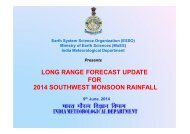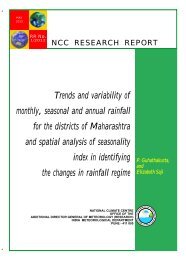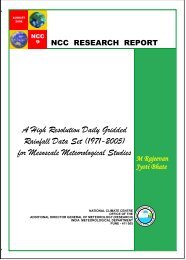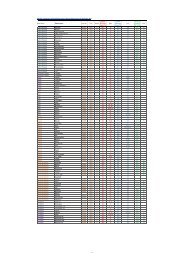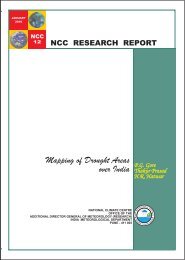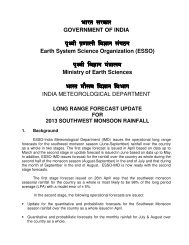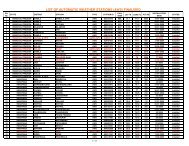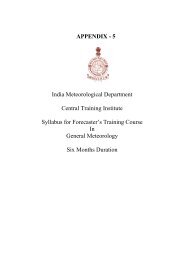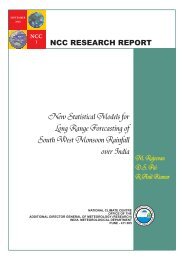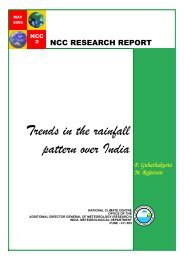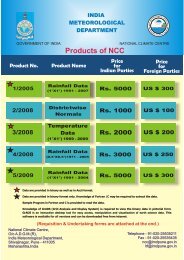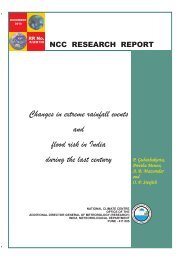BULLETIN OF IMSP - (IMD), Pune
BULLETIN OF IMSP - (IMD), Pune
BULLETIN OF IMSP - (IMD), Pune
- No tags were found...
You also want an ePaper? Increase the reach of your titles
YUMPU automatically turns print PDFs into web optimized ePapers that Google loves.
From Chairman’s DeskI feel extremely happy to address all of you as the chairman of IndianMeteorological Society, <strong>Pune</strong> Chapter through this issue of “Bulletin of<strong>IMSP</strong>”. I make use of this opportunity to thank all the members forunanimously electing me as the chairman and entrusting me theresponsibilities of leading <strong>IMSP</strong> for next two years. It will be my constantendeavor to lead the <strong>IMSP</strong> to newer heights, of course with the support ofall members and the dedicated team of the executive committee of <strong>IMSP</strong>.Besides the ongoing activities, more programs focusing promotion andpopularization of meteorology and allied sciences in all their aspects amongthe public and academic institutions are being planned. These include a seriesof popular lectures in various schools and colleges, quiz competition onmeteorology for students etc. We would like to further strengthen theinteraction, started by earlier council between academic institutions and<strong>IMSP</strong>. Many institutions are showing interest in monitoring weatherparameters at their premises. I wish to take this opportunity to reiterate<strong>IMSP</strong>’s commitment to assist the interested institution.I am happy to inform that the strength of <strong>IMSP</strong> has gone to morethan 300 including 186 life members. An updated list of all our members isappearing in this issue for the benefit of the members. I encourage all themembers to send their views, suggestions and constructive criticism throughemail at pune_ims@rediffmail.com.The new editorial board of “Bulletin of <strong>IMSP</strong>” has taken charge underthe leadership of Dr U. S. De. I am confident that in the coming years theBulletin of <strong>IMSP</strong> will further strengthen and fulfill its intended role of amedium of scientific communication among a wide spectrum of IMS membersand the public at large. I request all the members to communicateinteresting research articles, news items, briefs regarding visits, seminars,new projects etc to make Bulletin of <strong>IMSP</strong> an eagerly waited Newsletter.R. D. Vashistha3
Grid ComputingManoj Kumar TandonIndian Institute of Tropical Meteorology, Pashan, <strong>Pune</strong>.We are currently experiencing what can only be called the ‘Perfect Storm’ of innovationin not just one but many of the fundamental computer technologies of our day.Computing Systems, Storage Systems and Networking Systems are seeing exponentialgrowth in capacity and capabilities. Grid computing offers a suite of technologies thatexplicitly recognizes the new paradigms and economics of computing. Grid computing,like many other exciting contemporary technologies such as ‘Quantum Computing’, hasbeen developed and carefully nurtured by collective talent and dedication ofacademicians, researchers, scientists and technologists the world over. Grid computing isrevolutionizing the way institutions utilize information technology in their works. Gridcomputing takes collective advantage of vast improvement in microprocessor speeds,optical communications, raw storage capacity, the World Wide Web (WWW) and theInternet. Grid computing facilitates the “Poor Man’s Supercomputer”. A grid is adistributed computing network that pulls together a wide variety of different andgeographically dispersed computing resources to tackle numerous and large scalecompute intense tasks. Grid computing is one of the most exciting new frontiers incomputational science. It harnesses the power of diverse computer resources as neverbefore. Grid research will one day lead to huge distributed computing networks that willbring unimaginable compute power to bear on the biggest and most complex challengesin science and allow every user fast access to supercomputing type resources. Gridcomputing can be used across a wide range of other disciplines including Chemistry,Astrophysics, Geophysics, Financial Simulations, Mathematics, Computational Ecology,Medical Imaging, Weather & Climate Modeling and Interactive Molecular Design. Gridcomputing holds astounding potential to unite diverse compute resources as never before,forging together clustered desktop systems and the largest multiprocessor servers tocreate a virtual supercomputer. Grids bring terabytes of storage space and billions ofcomputer cycles to bear on today’s most taxing scientific and mathematical problems.Development of techniques and paradigms for exploiting distributed heterogeneouscomputing is one of the key and crucial segments in grid computing. Grid computing hasa middleware that integrates its parts into a coherent whole and manage the tasks fromsystem to system and architecture to architecture using interoperable message passinginterface protocols.Grid computing is being considered as the next big thing in computing. Computationalgrid is the core aspect of grid computing. Computational grids enable the sharing,selection and aggregation of a wide variety of geographically distributed computationalresources, such as supercomputers, compute clusters, data sources, instruments andpeople, and present them as a single unified resource for solving large scale compute anddata intensive applications like climate & weather modeling, brain activity analysis andmolecular design of drug analysis. Concept of a computational grid is analogous to thatof an electric power network (grid) where power generators are geographically1
distributed but the users are able to access electric power without bothering about thesource of energy and its geographical location. Computer scientists are considering gridcomputing as the next generation distributed computing. Grid is seen as the latest andmost complete revolution of more familiar developments such as distributed computing,the Web, peer-to-peer computing and visualization technologies. Grid computing keepsentire complexity hidden and its multiple users enjoy a single unified experience. UnlikeWeb which primarily enables communication, grid computing enables completecollaboration towards common goals. Unlike peer-to-peer computing, grid computingallows many-to-many sharing of files. Unlike clusters and distributed computing whichneed physical proximity and operating homogeneity, grids can be geographicallydistributed and heterogeneous. Unlike visualization technologies which visualize a singlesystem, grid computing enables the visualization of vast and disparate IT resources. Gridcomputing represents a big step forward in the world of computing. Grids are inherentlymore resilient and flexible than standalone systems. Properly configured grid has nosingle point of failure. On the flexibility side, grids are not limited to single applicationsbut can run many applications simultaneously without any of the resource constraints thatmay arise from running multiple applications on a single server.Like the Internet, grid computing also got its start in the research and academiccommunities. Grid computing uses more of a server’s computing power. Today’scomputers, like human brains, typically operate at only a fraction of their capacity; theyoften sit idle as a processor waits for data. On the grid, the idle time of hundreds, eventhousands, of servers can be harnessed by any user needing a massive infusion ofprocessing and computing power. Grids have given rise to the concept of a ‘VirtualOrganization’ consisting of ever changing groups of individuals and institutionsexploiting the resources of the grid for a variety of purposes, much the way thatindividuals in the same household exploit electricity for their own and different needs.The advent of broadband has enabled the networked computers on the grid to share dataconstantly at high speeds which is very critical to the functioning of any sophisticatednetwork like grid. In the context of grid computing we should however keep in mind thatinformation needs are increasing at an unimaginable rate every year. The largestcontributor to this enormous increase has been the networked nature of informationexchange and the growing dependence on networked services.In the realm of grid computing, ‘Data Grid’ represents network of distributed storageresources, from archival systems, to caches, to databases, that are linked together tocreate global and persistent identifiers. Data grids enable sharing of a very large amountof data and files that are distributed across remote storage repositories and evencontrolled by different administration domains. Grid architecture makes thesegeographically distributed files to appear to be local as if they are residing on your localdisk. Data grids have found applications in various projects in diversified fields viz.Physics, Chemistry, Astronomy, Ecology, Medical Sciences, Molecular Sciences,Seismology, Distributed Databases, and Neuro Sciences. Data grids are conceptuallycapable of providing mechanisms for describing geographically distributed data usingmetadata and annotations, and using this ‘data about data’ to discover data of interest.There is a lot of hype about grid computing, as is apparent from the number of different2
names it has been given by vendors as they try to differentiate their vision from everyoneelse’s. ‘Computing on Demand’, ‘Adaptive Computing’, ‘Utility Computing’, ‘OrganicComputing’, ‘Hosted Computing’ and ‘Ubiquitous Computing’ are just some of thenames given to ‘Grid Computing’ by different vendors. Grid computing is becoming thepreferred platform for next generation e-Science experiments that require management ofmassive distributed data. Just as an Internet user views a unified instance of content viathe Web, a grid user sees a single unified large virtual computer. Operational WeatherForecasting, Financial Modeling and Geophysical Explorations are some of the typicalapplications of grid computing.Grid computing offers scientists and technologists the ability to streamline their researchand undertake larger and more complex sets of problems than ever before. It is quitelikely that grid computing will play a vital and crucial role in tomorrow’s large and smalldiscoveries of computational science and will also improve the productivity amongresearchers and scientists. The ‘grid’ is acknowledged and recognized as one of the mostimportant and pioneering development in the field of computational scienceinfrastructure. Over the years, lifestyles have evolved with technology and there has beena continuous feeling and desire for global interaction in science, business, research,government and entertainment and grid is a decisive step in fulfilling this desire. Gridcomputing has heralded an era of ‘Global Grid Society’. Grid creates a virtual platformfor computation and data management similar to Internet which provides a virtualplatform for accessing information. Grid computing promises to democratize computingand computer power. There is a bright future for grid and “High PerformanceComputing” (HPC) in computational sciences. Grid computing has been universallyhailed as the next revolution after the mighty Internet and the Web. We should howeverremember that in the wake of the rise and fall of dotcom era, new technologies, like GridComputing, Nano Technology and Quantum Computers, that promise the moon and starsare often regarded with a healthy dose of skepticism. Technology expands our ways ofthinking about things and expands our ways of doing things. Technology can be a verypowerful force for intellectual innovation.DO YOU KNOW?1. What is the typical size of a cloud droplet?2. What is Harmattan?3. What is the radiative forcing due to Halocarbons?4. What is rated on saffir simpson scale of 1 to 5?5. Who introduced tephigram into meteorology?3
Global Warming and Common manU.S. DeThe latest assessment Report (AR – IV) of the IPCC leaves no doubt at all inmind of people that emissions of green house gases is the key to global warming. One ofthe key gases is carbon dioxide which accounts for the major part of this warming.Carbon dioxide is emitted upon burning of fossil fuel which is associated with generationof power in almost all sectors of development and growth. The sudden increase of CO 2started with industrial revolution which began in so called developed countries like USand Europe. We tend to follow this flawed path to development elsewhere as well. Thisdebate is an important agenda item even in the recent G-8 Summit.Economists have concluded that there is a direct relation between the existingdevelopment model and emission of green house gases.The Kyoto Protocol calls for a cap on the emissions of six green house gases i.e.CO 2 , CH 4 , N 2 O, HFCs, PFCs and SF 6 . However, even if the mitigation pathwaysuggested in the protocol is adopted the warming will continue for several decades infuture due to the inertia of the climate system and the residual effect of these gases whichhave life spans varying from tens of years to 500 years.Instead of going into political debate on the non ratification of Kyoto Protocol byUS and some other countries which are among the top ten in terms of cumulativeemissions during 1950 – 2003, let us see what we can do as an ordinary citizen to reduceemission. A recent global survey telecast over BBC showed that more than 80% ofpeople are really concerned about the impacts of climate change on our futuregenerations.A few steps by us to contain emissions are…i) If we save 1 watt of power per house hold per day then in a city with 10000household we can save nearly 365 x 10000 = 3650000 Watts of powerannually. That is 3650 kW of power leading to a decrease in fossil fuel usedto generate power. This can be done by increasing the use of natural light andnatural ventilation and CFL lamps.ii) If in a same city each household saves 10 litres of water per day then theannual water conserved will be (10 x 365 x 10,000 = 36500000 litres) 36500cubic meters of water. Since water is very much in demand due to growingpopulation and changes in rainfall distribution due to global warming, such asaving will be useful not only for conserving the scarce natural resource butalso will reduce power consumption as city water supply system use massivepumps to pump water.iii) Reduce the dependence on cars, scooters and other forms of auto transportsfor short distance movement and for longer distance travel use the concept ofcar pooling as far as possible.iv)Follow a low consumptive life style which will reduce energy use and reducewaste and garbage. These efforts will reduce emissions of CH 4 and SO 2 .v) Greater use of solar and wind energy in large residential, commercial andluxury townships, resorts, hotels.4
Apart from our efforts in reducing emission we can use certain measures whichcan be called adaptation to “global warming” in order to reduce its impact. Followingare some of these steps, which may be taken by citizens to grapple with impacts ofglobal warming and extreme weather events.i) Follow health precautions advisories to avoid sunstroke, de-hydration, etc.,during summer due to heat wave.ii) Like wise take proper care during winter to avoid exposure which may causecardio vascular ailments.iii) Use boiled / filtered water during the rainy season and during floods to checkwater borne diseases.iv) At the community level develop coastal dykes and shelters to reduce theimpact of sea level rise and increase frequency of tropical storms.v) Use clothes suited to changing climate rather than being fashion oriented.vi) Using and cultivating crops & fruits in tune with changing climate of theregion or place.These adaptation measures at the citizen’s level are ‘no cost’ or minimal cost, benefitsand promote a sustainable life style also in the context of global warming. Each region,country, city and citizen can contribute to these efforts. A bottoms-up approach fromcitizen upward appears a viable option. Let us give it a try.AnswersDO YOU KNOW?1. 10 µm2. Severe dust storm/dust raising winds in north Africa particularly.3. It is about 14% of the total radiative forcing due to various constituents.Incidently, nearly 60% of the radiative forcing is due to CO 2 .4. Hurricane5. Sir Napier Shaw5
“Ides of March” of 2007 year – an Indian Experience!O.N. DHAR and Shobha NandargiIITM, <strong>Pune</strong>-411 008.Shakespeare in his famous drama ‘Julius Caesar’ has immortalized the15th of March as“Ides of March”. Caesar, the great emperor of Rome, was warned by sooth-Sayers andeven by his own life that 15 th of March was not auspicious day for the Caesar and heshould not move out of his palace. Being a brave soldier and conqueror, he did notbother about their warnings and replied them in the following words:-‘Cowards die many times before their deaths,The Valiant never taste of death but once,Of all the wonders that I have seen,It seems me most strange that men should fear,Seeing death a necessary end will come when it will come.’Actually Caesar was killed by his own Roman cabinet colleagues, which included thehonorable Brutus, whom he considered most honest and trusted friend, on 15 Marchduring a cabinet meeting.As is well known, meteorologically, the month of March is quite important as on23 rd March Sun crosses the Equator from the south to the north and on this date, night andday are of equal length. On this day, World Meteorological Organization (WMO),Geneva, celebrates its foundation day at its affiliated Met. Organizations all over theworld! A British poet has said that March wind and April showers bring forth the Mayflowers!This year (2007) “Ides of March” has been quite distressing in India too! Acouple of days before 15 March, the entire northwest and northern India were affected byunseasoned snow and rainstorm which baffled even the weather man by their severity!Dozens of people were killed and standing crops were destroyed over a wide area ofnorthwest India. As if this was not enough, on 14 March, there was unprovoked firing oninnocent farmers at Nandigram in West Bengal, which killed 14 poor farmers and injuredscores of them! This incident resulted in adjournment of both Houses of Parliament inNew Delhi without transacting any business on 15 March in memory of the dead!What happed actually on 15 March, 2007 was more gruesome! 55 policemencamping in the Chhatisgarh State were massacred by Naxalite terrorists in the early hoursof dawn when they were fast a sleep! As if this was not enough, during the day time of15 March, some dozens of pool coal miners working in a neighboring coal mine gottrapped in the flooded coal mine and met their watery grave under tragic circumstances!We may not believe in the concept of some days are auspicious and some areotherwise but when actually happened on 15 th March, 2007 in this country, defied allrational explanation and at the same time it is hard to pass it as a simple coincidence! Wefeel that there is some truth in the famous saying of “Beware the Ides of March”!6
Recommendations of the Indian Meteorological Society Workshop on ClimateChange and Extreme Weather Events, 18-20 April, 2007, New DelhiIMS, New DelhiThe workshop discussed the various facets of climate change, with particularreference to global and regional issues in the Indian context. 13 presentations by eminentexperts covering the three major theme areas viz. Issues related to Climate Change,Indian Monsoon and Climate Change and Climate Change and Extreme WeatherEvents were made. 55 Participants drawn from 12 agencies participated. Recent releaseof two important IPCC assessment reports helped steer discussions on the latest views onthe international science community. Every presentation was followed by Q&A sessionsthat enabled the emergence of views on the nature of research that young scientists couldtake up and also helped in compilation of recommendations on research priorities. Anexclusive session on feedback presentations by participants was a unique feature thatresulted in incorporation of views of the younger researchers in the recommendations.Recommendations emerging out of the two day meeting are listed below:• Importance and need for enhancing the networks of systematic observations wasrecognized. Maintenance of high standards for climate observations andstrengthening of networks for climate monitoring of key elements of physical,biological systems for carrying out regional assessments was identified as a majorthrust area. Standard data bases on climate parameters and related physical andbiological parameters must be created and made available to researchers.• Further research on the regional impacts of aerosols, both direct and indirect effects,and how this forcing changes with time and modulates the global forcing of theGHGs. This of particular importance in understanding climate change effects on themonsoon system.• Current climate change scenarios indicate a decrease in number of rain days and anincrease in heavy rainfall events. Although, such changes will not manifest astrends in total rainfall amount, they will impacts sectors like agriculture and waterresources. Therefore, extensive studies based on archived models results, as well asadditional modeling efforts based on global and regional model runs must beundertaken in a coordinated fashion.• There is an urgent need to encourage young scientists to undertake research inclimate science. It is felt that lack of trained manpower in weather and climatestudies in India is one of the reasons for which not enough modeling studies areundertaken. Hence, IMS may organize more such activities.• Climate change issues are not properly disseminated amongst the nonmeteorologistsin the country. Scientific, policy and mitigation issues can beexplained to the educated youth through more workshops of the type of the currentone. IMS should take strong steps in regard to education and training of the youth.• In order to give proper emphasis to science of weather and climate, IMS may set upIndian Academy of Meteorological Science (IAMS).7
New particle formation in the atmosphereDevendraa Singh *Indian Institute of Tropical Meteorology, <strong>Pune</strong>, India* Current affiliation; Institute of Environmental Physics, University of Tartu, 18 UllikoliStreet Tartu 50090, EstoniaEarth-atmosphere system influence by aerosol in several distinct ways; the humanhealth effects of fine particulate matter constitute the most important element informulating the national ambient air quality standard. Also, an aerosol directly orindirectly affects the Earth radiation budget, and light absorption by aerosols causesvisibility degradation. Further more, modification of clouds and precipitation by aerosolsmay enhance lightning activity and thus influence tropospheric chemistry. The impacts ofparticulate matter on heath, radiation, and cloud microphysics are strongly dependent onthe particle size.Recent work has shown that new particles are often formed by nucleation in theatmosphere. Most of the atmospheric particles are the product of various gas-to-particletransformation processes: Homogenous nucleation (in homogenous nucleation one ormore vapour form a cluster without a seed particle or ion); Ion-induced nucleation (Ioninducednucleation the vapour condense around an ion, this nucleation is a special case ofheterogeneous nucleation); kinetic nucleation (based on kinetically limited nucleationwhere the nucleation is barrier less but limited by vapour molecule collision rate);Heterogeneous nucleation (this nucleation is a process where vapours nucleate on thesurface of a pre-existing particle).The species and mechanism responsible for nucleation are not well understood,and probably vary from location to location depending on the concentrations of tracespecies that can react to form new particles. Much of previous work has focused onnucleation of sulphuric acid, because sulphate represents important components of thenucleation mode aerosol. It is commonly recognized that binary nucleation of H 2 O-H 2 SO 4 is not efficient enough to explain atmospheric new particle formation. Thenucleation of H 2 SO 4 vapour into H 2 SO 4 / H 2 O ion clusters is believed to be an importantprocess and has been studied theoretically and experimentally. According to the classicaltheory, conditions that favour ion-induced nucleation by this process include lowtemperature, high relative humidity, high production rate, and low concentrations of preexisting particles. A detailed kinetic model based on experimentally obtainedthermodynamic data of H 2 SO 4 / H 2 O ion cluster show that ion-induced nucleation for thissystem will only occur, when appropriate conditions for H 2 SO 4 , RH and temperature arelow. The conditions are often met in the upper troposphere and lower stratosphere.Homogenous nucleation (HN) is an important source of new particles in theatmosphere. HN of only one substance requires very high super saturations, which is notdetected in the atmosphere. HN includes binary homogenous nucleation (BHN) sulphuricacid-water (H 2 SO 4 - H 2 O) and ternary homogenous nucleation (THN) (or multicomponent homogenous nucleation) of sulphuric acid – ammonia- water (H 2 SO 4 - NH 3 -H 2 O). Some experimental results support the theory of these process, although theagreement between experimental and theory is only qualitative. BHN has been used to8
explain nuclei-mode (~ 5 to 100 nm, particle diameter) aerosol concentrations in thetropical upper troposphere. Marine boundary layer and continental areas, particleformation rates are observed to be much higher than that predicted by BHN, and some ofthese discrepancies have been explained by THN. Because ammonia acts to stabilize thecritical embryos (~ 1 to 2 nm), the nucleation rates of THN are higher than the BHN rate.There are large uncertainties in the prediction of classical HN theory because it is on thebasic of the liquid drop model, which is not valid for small molecular cluster.Nucleation involving background gas-phase-ions generated by galactic cosmicrays is another potentially important atmospheric nucleation process. The thermodynamicadvantage of ion-induced nucleation (IIN) is an enhancement in the stability ofelectrically charged clusters and higher particle growth rates because of electrostaticforces. Model studies of IIN have been made, but these calculations have used poorlyconstrained parameters and constrained considerable uncertainties because of the lack ofdata on the thermodynamic properties of charged molecular clusters. Several factorsfavouring IIN exist in the UT-LS, including relatively high ion-production rates by GCRs(upto ~20–30 pairs of ions cm -3 s -1 ), low temperature, and relatively low surface areas ofpre-existing aerosol.Recent availability of instrumentation for measuring mobility distribution of small(0.36-1.6 nm diameter) and intermediate (1.6-7.0 nm diameter) ion in the atmosphereprovides another rich source of information for quantifying the role of ions in newparticle formation. Ion mobility distribution measured during nucleation events show thegrowth of small ions into the intermediate ion size range. Such data along withmeasurements of total (neutral plus charged) size distributions provide an independentapproach for inferring the relative contributions of neutral nucleation and IIN to newparticle formation.Small positive and negative ions are always present at ground level and aretypically present is roughly equal concentrations. Direct qualitative evidence for INN isthe formation of intermediate ions of one polarity but not the other. This can occur whenvapour condenses preferentially on small ions of one polarity because of the affinity ofthe vapour for that charge. Such charge asymmetry in the formation of intermediate ionswas observed in Tahkuse, Estonia. Also laboratory studies show that negative IIN occurswhen particle are formed as a results of radioactive decay in mixtures of H 2 O and SO 2 inN 2 . IIN occurred or not can be also obtained from measurement of the fraction ofparticles of a given size that are neutral, or negatively or positively charged.AcknowledgementThis article prepared partly with the support from DST under BOYSCASTprogramme with reference (SR/BY/A-19/05).9
Some reminiscences of Dr, PisharotyO. N. DharIndian Institute of Tropical Meteorology, <strong>Pune</strong>I was deputed for Snow Survey work from India Meteorological Department(<strong>IMD</strong>), New Delhi to Cyclone Warning Center (CWC), New Delhi in March 1947. Onbeing selected by the UPSC in 1951, I returned to <strong>IMD</strong> and was posted to MeteorologicalForecasting Office at Safdarjung airport, New Delhi. At that time, Dr. Pisharoty wasMeteorologist-in-Charge of that office.Soon after joining the Met. Office, Safderjung, Dr.Pisharoty put me in theforecasting officer's roster-duty although I was completely untrained for the job! He toldme that he believed that a man quickly picks up the work when he is actually put in thatseat/job. He gave me an example of a man who is thrown in a river. To save his life hewill struggle with all his might and in that process he will learn swimming and savehimself. I had to work very hard for a couple of weeks to learn the technique offorecasting including learning the various weather codes, analyses of different WeatherCharts and all other items of work connected with the duty officer's job. I now feel that ifhe had not put me in the Duty officer's seat at the very beginning, I would have takenmonths to pick up the various items of work. This is just an example of Dr. Pisharoty'smethod of training his staff and officers without any loss of time. Of course, he wouldstand by his people if there was any mishap or mistake made unintentionally.During those days, it so happened that I came a bit closer to Dr.Pisharoty. Afriend of his, viz. Dr.S.Parthasarthy, who was then senior Deputy Director (I/CUltrasonic Division) in the NPL, New Delhi happened to be a friend of my father.Dr.Pisharoty and Dr.Parasarthy were both students of Sir. C. V. Raman in Bangalore andas such they were close friends. Naturally, when Dr. Parthasarthy came to know that Iwas working under Dr.Pisharoty, he just put in a word about me to Dr. Pisharoty. Thisworked well and naturally, Dr. Pisharoty took more than normal interest in me.Dr.Pisharoty did not remain long in the Safdarjung Met. Office as he had to go toUSA for higher studies in meteorology under the UN/WMO project. Towards the end of1952, he left for USA and remained in USA for 2 years. He successfully completed bothM.S. and Ph.D. Degrees in meteorology in just two years' time which is a record. Veryfew Indians have achieved this distinction of completing M.S. and Ph.D. Degrees in twoyears in USA.When I was working in CWC, New Delhi, I came in contact with Dr. J.E.Church,who was then the President of International Commission of Snow and Glaciers. He was ameteorologist of the Nevada University, USA. He was invited by the Govt. of India totrain a few young Indians with good meteorological background, for Snow Surveying inthe Himalayas. I was one of the four young boys selected for this training by Dr.K.R.Ramanathan, then Officiating DGO and by a Member of CWC. We were trained by Dr.Church in the snow fields of Kosi Himalayas in eastern Nepal for a couple of months.It was so happened that Dr. Church was pleased with my work and recommendedme for further training in USA which did not materialize. When he returned to USA herecommended my name to several USA Universities who gave me admission topostgraduate courses in Meteorology. On Dr. Church's recommendation, I was also made10
a regular member of the American Geophysical Union, Washington in 1951. Dr. Churchalso wrote to Prof. Berkenis of the California University about me. At that time Dr.Pisharoty was studying in USA under Prof. Berkenis and he asked Dr. Pisharoty to writeme asking me to join the California University. Dr. Pisharoty wrote several letters to mefrom USA asking me to avail of this opportunity when there were so many people tryingto help me. As ill luck would have it, due to financial constrains, I could not avail of thisopportunity! On his return from USA, I met Dr. Pisharoty in New Delhi and he told methat I missed a great opportunity when there were many people ready to help me.After return form USA, Dr. Pisharoty was posted as Director in the Offices of<strong>IMD</strong> at <strong>Pune</strong> and Bombay. I lost contact with him for a good number of years, but thiscontact was resumed in 1965 when I joined IITM, <strong>Pune</strong> on being selected by the UPSCfor one of the four posts of Senior Scientific Officer in IITM, <strong>Pune</strong>. Dr. Pisharoty wasalready selected as the Director of IITM, since Nov., 1962 and he remained in that postup to the end of 1966. After his retirement from IITM, by the end of 1966 he joinedPRL, Ahmedabad but whenever I got a chance to meet him, he would tell me that hewas very much interested in the type of studies that I was carrying out in IITM. This factwill also be clear from the following -When he was at Ahmedabad I normally used to send him reprints of my papers.It also happened that on my sending him a reprint of the paper on 'Break monsoon'rainfall in the Himalayas (Published in the Int. J. of Climatology, UK) he wrote me backin his letter dated 14 April, 1985 - "As usual, your study about the rainfall over theEastern Himalayas, during the 'breaks' has been exhaustive. Your rainfall studies havemade the establishment of IITM, <strong>Pune</strong> worth while. The Nation has to be grateful to youfor your silent efforts and 1 record my gratitude once again, as a citizen of India!"In this connection it may be relevant to mention here that he sent me a copy ofhis letter dated 23 March, 1989 from Ahmedabad warning the authorities at Delhi on thebasis of my paper entitled "Hydro meteorological study of Sept., 1880 rainstorm whichcaused the greatest rain depths over northwest UP. In that letter to Delhi Authorities hewrote that he had a hunch that such a flood situation or something nearly equal mayoccur in Delhi and its neighbourhood in Sept. 1989 or 1990. He suggested that a projectbe initiated to simulate the Hydrologic, Economic and Social Consequences of such aflood calamity. The letter contained a copy of the isohyetal map of the rainstorm withthe words "after Dhar, IITM".In recent years after his shifting to <strong>Pune</strong> from Ahmedabad, I did meet Dr.Pisharoty several times both in IITM and at his residence. Of course, he was very kindand courteous towards me and used to call me as the person who had been going to theHimalayas. I also remember that when I was to leave for USA for training inHydrometeorology in Nov., 1966, he came to my residence at <strong>Pune</strong> with his wife toconvey me his blessings personally!The above are some of my reminiscence of Dr. Pisharoty. I remember him withgratitude and deep respect. He was a great meteorologist and above all a fine nobleperson with broad human sympathies!11
How the Palghat Gap can influence the north-south rainfalldistribution across its axis?S. Dutta, P.P.Toro and S. Das GuptaOffice of the DDGM(WF), <strong>IMD</strong>, <strong>Pune</strong>.Palghat Gap (PG), about 40 km wide & 80 km long, is a gap in the Western Ghats(WG). Climatologically normal rainfall pattern during the Southwest monsoon seasons(SWMS) over south peninsular India shows an area of rainfall discontinuity near PG(fig.1). Divergence caused due to Bernoulli’s effect in the gap flow is generally attributedto this effect.Observed downwind increase of wind speed transiting the PG at its eastern endmade by Ramachandran et al. (1980) was attributed to divergence in the lower levels atthe gap exit. The study also suggested a dynamical study, using a dynamical model, toconfirm their ideas.Asnani (1993) explained the above divergence using the familiar analogy of theventuri effect. But venturi effect is not always the correct explanation for gap winds.Because, unlike the tube or nozzle of engineer’s venturi, the mountain gap is not a fullyenclosed space but a channel with an open top, that is, no rigid upper lid restricts the flowto three-dimensions.To explore for a plausible dynamical explanation for the observed downwindincrease of winds transiting the PG, as mentioned above, a dynamical model (Dutta 2005)for meso-scale airflow across a meso-scale 3-D orographic barrier has been used. Themountain gap has been synthesized by two-meso-scale three-dimensional ellipticalbarriers and is shown schematically in fig.2. Vertical profile of perturbation verticalvelocity ( w′) at different points at the exit (eastern end) of the gap, computed using theabove model, are shown in fig 3(a) and 3(b).From the figures it is clear that at x=35km and x = 40km, w′ decreases with height.Hence there is perturbation horizontal divergence at the gap exit. This divergence maycause a cyclonic / anti cyclonic turning of the streamlines to the north/ south of the gapaxis near its exit. Further details of this numerical experiment may be found in Dutta et al.(2006).Thus it appears that low level perturbation horizontal divergence at the gap exit iscaused due to decrease of perturbation vertical velocity with height. This divergence inturnmay cause a cyclonic/anti-cyclonic turning of the streamlines to the north/south ofthe gap axis at the exit, which again may be attributed for the observed difference in themean seasonal rainfall during SWMS to the north and south of the PG.REFERENCES:Asnani.G.C, 1993, “Tropical Meteorology”, Volumes 1 & 2, IITM, <strong>Pune</strong>-411008, India.Dutta, Somenath., 2005: Effect of static stability on the pattern of three dimensionalbaroclinic lee wave across a mesoscale elliptical barrier. Meteorology andAtmospheric Physics, 90, 139-152.12
Dutta, Somenath., Mukherjee, A.K. and Singh, A.K., 2006, Effect Of Palghat Gap OnThe Rainfall Pattern To The North & South Of Its Axis, Mausam,57,4, 675-679.Ramachandran, G., Rao K.V, Krishna K.,.1980,”Observational study of Boundary layerwinds in the exit region of a mountain gap”, J. of Appl. Meteorlology., 19, 281- 288.800PALGHATJULYRAINFALL(mm)600400SOUTH STATIONSNORTH STATIONSJUNEAUGUST200SEPTEMBER1030 1035 1040 1045 1050 1055 1060LATITUDEFig.1: Variation of rainfall with latitude atdifferent stations during SWMSFIG.2:A SCHEMATIC REPRESENTATION <strong>OF</strong> AGAP BETWEEN TWO MESO-SCALE 3-D ELLIPTICAL BARRIERS10108866Z (km)4Z (Km)422000.10 0.15 0.20 0.25 0.30 0.35 0.40 0.45 0.50w' (m/s)FIG.4(A):VERTICAL PR<strong>OF</strong>ILE <strong>OF</strong> w' AT X=35KM ALONG GAP AXIS0.05 0.10 0.15 0.20 0.25 0.30 0.35 0.40w' (m/s)FIG.4(B):VERTICAL PR<strong>OF</strong>ILE <strong>OF</strong> w' AT X=40KM ALONG GAP AXIS13
What causes lightning flashes to occur?C. U. UpadhyeIndia Meteorological Department, <strong>Pune</strong>Lightning is a spark, an avalanche of electrons rushing suddenly from one spot toanother, so fast and in such a quantity that they cause the air to glow.As water drops form and are blown upward in the center of a thunderstorm, mostfreeze into silvery ice crystals. They continue to rise accumulating more moisture, andgrow into mushy lumps of hail called grauple. Then they fall, bounce up, fall, blow upagain, accumulating more and more layers while supported in vertical winds so strongthey can lift hail as large as softballs.Each time the hail falls lower in the cloud it crashes into the rising crystals of ice,knocking off and collecting negative ions, and becoming negatively charged. The risingmist and ice crystals are left positive. Soon, the cloud top acquires an overall positivecharge while a hail and grauple produce a general negative charge at lower altitudes.When they build up, becomes strong enough electrons suddenly rush to the areaof positive charge, usually within the cloud or they may flash between clouds or evensideways into a cloudless sky.In a typical cloud-to-ground flash, as the cloud’s field changes, so do theelectrical characteristics of the ground under it. In at least 90 percent of cases, thenegative bottom of the cloud drives away negatively charged particles on the groundssurface, resulting in an overall positive charge there.A small, innocuous flow of free electrons begins between the earth and the cloud.Suddenly, the charge becomes large enough to break through insulating barrier of air.Electrons zigzag earthward at about 60 miles a second in what is called a “Steppedleader” each step perhaps 180 feet long (Nobody knows what it is stepped). It producesan ionized channel – molecules in the path are stripped of electrons an inch or so wide.The leader may split then split again. This stroke is not terribly potent; it carries perhapsonly 500 amperes or so and produces almost no light. When the negative leader reachesthe ground, small positively charged “connecting discharges” or upward streams” strikefrom upward projecting objects, tracks, steeples, golfers, and photographers in openfields touch metal tripods.When one of the streamers and leader meet, the circuit closes, a colossal returnstroke blasts upward at about half the speed of light and an average of 30,000 amperesthrough the leader tunnel. The air heats as high as 60,000 0 F (5 times the surfacetemperature of the sun) and its supersonic expansion produces a shockwave that becomesthunder.Things may stop there, but in most flashes after a pause, a “dart leader” using thestill hot channel zips down from the cloud (usually without the steps) and in turn triggersone or more subsequent return strokes.All the strokes back and forth each lasting about a millisecond-are what causeslightning to flicker.14
Cherrapunji & Mawsynram: Wettest Places on the EarthD. S. Pai and Pulak GuhathakurtaIndia Meteorological Department, Shivajinagar, <strong>Pune</strong>.Cherrapunji (elevation 1313m) is a station situated at the southern slopes of theKhasi Hills of Meghalaya, (Meghalaya means ‘abode of clouds’) in northeast India.Mawsynram (elevation 1401m) another station in Meghalaya is situated only 16kilometers west of Cherrapunji. Blessed by the rain Gods, both these places, Cherrapunji& Mawsynram, receive abundant rain throughout the year except during the wintermonths. In these areas, the main mechanism of rainfall areas is the direct orographiclifting of air. However, heavy rains also occur in association with the cyclonic storms.During the pre and post monsoon periods, these areas experience short, sharp convectiveshowers. On the other hand the summer monsoon rainfall is mostly orographic.The rainfall observation at Cherrapunji was started in late 19 th century itself.However, the automatic rainfall monitoring was introduced in the early 1970s. AtMawsynram, the rainfall observations were started only in the beginning of the 1940s.Thapliyal and Kulshrestha (1992a) found that the annual mean rainfall for Mawsynram(1941-1978) is 11,873 mm, while it is 11,314 mm for Cherrapunji (1852-1987). Fromtheir analysis it was concluded Mawsynram in the Meghalaya as the rainiest place in theworld (on the basis of annual rainfall) ahead of Cherrapunji and another station Waialeale(elevation 1548 m and mean annual rainfall 11,438 mm (1911-73)), in Hawaii, USA.However, it is to be noted that the data period used for Mausynram was 38 years ascompared to 63 years for Waialeale and 138 years for Cherrapunji. We computed meanannual rainfall of Mawsynram and Cherrapunji using data for a common period of 1940-2005, during which data were available from both the stations. As per this computation,the annual mean rainfall of Mawsynram and Cherrapunji is 11510.9 mm and 11150.4mmrespectively. Thus Mawsynram can rightly be called as the wettest place of world.But for the annual mean rainfall, the Cherrapunji has a series of world records in itscredit for observed rainfalls pertaining to different time durations. Some of the significantrainfall values, which were collected from the data archive of India MeteorologicalDepartment, Beresford & O’Hare, 1998 and Blandford (1886-1888) are listed below.Time Duration Rainfall Date1 hour 420 mm 16 th June 19951 day 1563 mm 16 th June 19952 day 24930 mm 15-16 June 19954 days 3721 mm 12-15 September 19741 month 9300 mm July 18612 months 12767 mm June-July 18613 months 16369 mm May-July 18616 months 22461 mm April-September 186115
12 months 26461 mm August 1860-July 18611 Calendar year 22992 mm 18612 Calendar years 40768mm 1860-61On comparing these values with that listed in (WMO, 1994), it can be found that,except the value for 1 day duration rainfall, all other values can be categorized as thehighest ever recorded in the world. The highest ever rainfall for 1 day duration is1825mm recorded on 8 th January, 1966 at Foc-Foc, La Re’union, a small island in theIndian Ocean. We have not so far come across any past or recent publication that isquoting rainfall values higher than that is mentioned here.References:Beresford, A. K. C. and O’Hare, G., 1998, A comparison of two heavy rainfall events inIndia: Bombay, 24 July 1989 and Cherrapunji, 12 June 1997, Weather, 53, pp34-43.Blanford, H. F., 1886-1888, Memoirs of India Meteorological Department, <strong>IMD</strong>.Thapliyal, V. and Kulshrestha, S.M., 1992, Which is the rainiest place in the World,Mausam, 43, pp331-332.WMO, 1994, WMO Guide to Hydrological Practice, WMO No. 168, pp. 403.16
LIFE MEMBERSMEMBERS’ LIST IMS, PUNE CHAPTERS. N. LM NO. NAME ADDRESS & PHONE NO.1. LM-02 Dr G. C. ASNANI 822, Sindh Colony, Aundh, <strong>Pune</strong>-411 007(Ph: 020-25880347)2. LM-12 Shri V. N. ANKARKAR <strong>IMD</strong>, PUNE.3. LM-18 Dr D. A. MULEY 8/10, Sakal Nagar, Baner Road, <strong>Pune</strong>- 411 007.4. LM-19 Shri K. K. RAMAMURTY <strong>IMD</strong>, PUNE.5. LM-37 Dr N.Y. KHAMBATE <strong>IMD</strong>, PUNE.6. LM-58 Dr H. V. K. RAGHUVENDRA <strong>Pune</strong>7. LM-163 Dr V. THAPLIYAL 21/ D1, Ratan Park, Sus Road, <strong>Pune</strong>- 411 021.(R) 25861334, (M) 98231710968. LM-286 Dr M. RAJEEVAN <strong>IMD</strong>, Shivajinagar, <strong>Pune</strong>- 411 005rajeevan61@yahoo.co.in9. LM-319 Dr O. N. DHAR 2/58, Patil Estate, Bombay <strong>Pune</strong> Road, <strong>Pune</strong>- 411 005.10. LM-320 Dr G. B. PANT TRJ Roop Bungalow, 13/1, Madhukunj Housing Society, Panchwati, Pashan, <strong>Pune</strong>-8Ph: 020-25893533 (M) 9322029309, Email: gbpant@yahoo.com / @tropmet.res.in11. LM-321 Dr H. N. BHALME Flat No-27, Vishnu Baug Co-op. Housing Society, Chatushringi Road, <strong>Pune</strong>-1612. LM-322 Dr B. PARTHASARTHY 43/11, Vandan, Off Karve Road, <strong>Pune</strong>- 411 004.13. LM-323 Dr P. R. RAKHECHA Flat Above Jagdamba Sweets, Pimpri, <strong>Pune</strong>- 411 017.14. LM-324 Dr L. S. HINGANE IITM, Dr. Homi Bhabha Road, Pashan, <strong>Pune</strong>- 411 00815. LM-325 Dr K. RUPA KUMAR B-2, Mont Vert-2, Pashan, Sus Road, <strong>Pune</strong>- 411 021.Email: kolli@tropmet.res.in16. LM-326 Dr A. K. KULKARNI 66, Budhwar Peth, Nandewada, Near Tulsibaug Temple, <strong>Pune</strong>- 411 002.17. LM-327 Dr N.SINGH IITM, Dr. Homi Bhabha Road, Pashan, <strong>Pune</strong>- 411 008Ph: 020-25893600 (R), nsing@tropmet.res.in, singhnityaanand@hotmail.com18. LM-328 Shri B. N. MANDAL IITM, Dr. Homi Bhabha Road, Pashan, <strong>Pune</strong>- 411 00819. LM-330 Dr K. KRISHNA KUMAR B- 13, MONT VERT- 2, PASHAN-SUS ROAD, PUNE- 411 021.Email: krishna@tropmet.res.in20. LM-331 Smt N. A. SONTAKKE IITM, Dr HOMI BHABHA ROAD, PUNE-411008.21. LM-332 Shri R. B. SANGAM 5/5, Lake View Co-op. Society, Sutarwadi, Pashan, <strong>Pune</strong>- 411 021Ph: 25882488, Email: sangamrb@gmail.com22. LM-333 Dr. H. P. BORGAONKAR Flat-3, Unit-A2, Sukhwani Imperial, Morwadi-Aimera Road, Pimpri,<strong>Pune</strong>-18. Ph: 27473952, 9371028762 (M), hemant@torpmet.res.in23. LM-335 Smt LEELA GEORGE Flat No. 2-B, Patil Complex, 37, Aundh Road, <strong>Pune</strong>- 411 003.24. LM-336 Dr P. S. SELVEKAR IITM, Dr. Homi Bhabha Road, Pashan, <strong>Pune</strong>- 411 00825. LM-337 Shri S. S. ARALIKATTI Flat No. 17, Building C-3, Madhuraj Nagar,Opp. Jaibhawani Nagar, Paud, Kothrud, <strong>Pune</strong> - 411 029.26. LM-338 Shri C. M. MOHILE B/29, Swojas Complex, Parihar Chawk, Aundh, <strong>Pune</strong>- 411 007.Ph: 020-25890231, 020-5626258527. LM-340 Dr S. RAJAMANI 48, 4 th Main, 1 st Cross, Coconut Garden, Arakere, Bangalore- 560 076.28. LM-341 Dr S. N. BAVEDEKAR M-13/132, Maharashtra Housing Colony, Janawadi, Gokhale Nagar, <strong>Pune</strong>-16.29. LM-342 Shri S. SINHA IITM, Dr. Homi Bhabha Road, Pashan, <strong>Pune</strong>- 411 00830. LM-343 Shri D. K. PAUL 5, Ambika Housing Society, <strong>Pune</strong>- 411 016.31. LM-344 Shri R. H. KRIPALANI C2/ 17, Padumjee Paradise, 383, Bhawani Peth, <strong>Pune</strong>- 411 042.Ph: 20-26356941, Email: krip@torpmet.res.in32. LM-345 Shri P. SEETHARAMAYYA IITM, Dr. Homi Bhabha Road, Pashan, <strong>Pune</strong>- 411 00833. LM-346 Shri P. N. MAHAJAN IITM, Dr. Homi Bhabha Road, Pashan, <strong>Pune</strong>- 411 00834. LM-347 KUMARI. P. L. KULKARNI IITM, Dr. Homi Bhabha Road, Pashan, <strong>Pune</strong>- 411 00835. LM-348 Shri M. Y. TOTAGI IITM, Dr. Homi Bhabha Road, Pashan, <strong>Pune</strong>- 411 00836. LM-349 Shri D. R. TALWALKAR 36, PADMADSAN SOCIETY, PUNE- 411 009.37. LM-350 Smt U. V. BHIDE IITM, Dr. Homi Bhabha Road, Pashan, <strong>Pune</strong>- 411 00838. LM-351 Shri J. R. KULKARNI “Vaintey”, Plot No. 31, Rajyog Housing Co-op. Society,Baner-Mahalunge Road, Baner, <strong>Pune</strong>- 411 045.39. LM-352 Shri R. M. KHALADKAR 17/ 5, Shindenagar, Bavdhan (Khurd), Pashan-NDA Road, <strong>Pune</strong>- 411 021.Ph: 22951763, Email: khaldkr@tropmet.res.in40. LM-353 Shri V. R. MUJUUMDAR IITM, Dr HOMI BHABHA ROAD, PUNE-411008.41. LM-354 Dr. A. H. MULLAN No. 4, Ardeshir Baug, Irani Road, <strong>Pune</strong>- 411 002.42. LM-355 Smt A. A. KULKARNI IITM, Dr. Homi Bhabha Road, Pashan, <strong>Pune</strong>- 411 00843. LM-356 Shri S. P. GHANEKAR IITM, Dr. Homi Bhabha Road, Pashan, <strong>Pune</strong>- 411 00844. LM-357 Shri P. V. PURANIK IITM, Dr. Homi Bhabha Road, Pashan, <strong>Pune</strong>- 411 00845. LM-358 Shri R. K. VARMA IITM, Dr. Homi Bhabha Road, Pashan, <strong>Pune</strong>- 411 00817
46. LM-359 Smt S. G. NAGAR IITM, Dr. Homi Bhabha Road, Pashan, <strong>Pune</strong>- 411 00847. LM-360 Shri K. K. SINGH IITM, Dr. Homi Bhabha Road, Pashan, <strong>Pune</strong>- 411 00848. LM-361 Dr A. S. R. MURTY B- 1, Aradhana, 42/2 A, Shivajinagar, <strong>Pune</strong>- 411 005.49. LM-362 Dr P. C. S. DEVARA House No. 14, Shree Bhagawati Nagar, Pashan, <strong>Pune</strong>- 411 008.Ph: 91-020-25881502, devara52@yahoo.com, devara@tropmet.res.in50. LM-363 Shri P. N. SHARMA Vasundhara Apartments, 51- A, Kasturba Society, Vishrantwadi, <strong>Pune</strong>-15.51. LM-364 Dr R. VIJAYA KUMAR IITM, Dr HOMI BHABHA ROAD, PUNE-411008.52. LM-365 Dr S. S. PARASNIS Dattaprasad Housing Society, Plot No. 587, Singhgad Road, <strong>Pune</strong>- 411 030.53. LM-366 Shri G. K. MANOHAR 50-51, Akashdeep Co-op, Housing Society, Bhosale Nagar, <strong>Pune</strong>- 411 007.54. LM-367 DR K. INDIRA JOSHI IITM, Dr. Homi Bhabha Road, Pashan, <strong>Pune</strong>- 411 00855. LM-368 Dr P. S. PRAKASHRAO IITM, Dr. Homi Bhabha Road, Pashan, <strong>Pune</strong>- 411 00856. LM-369 Dr A. K. KAMRA I & O. T. Division, IITM, <strong>Pune</strong>- 411 008.kamra@torpmet.res.in57. LM-370 Shri K. G. VERNEKAR Clarion Park, Aundh, <strong>Pune</strong>- 411 007.58. LM-371 Shri S. K. JADHAV IITM, Dr. Homi Bhabha Road, Pashan, <strong>Pune</strong>- 411 00859. LM-373 Dr RAJ ERNEST PULIDINDI B-8, Mont Vert-2, S. No. 128/2A/1, Pashan, Sus Road, <strong>Pune</strong>- 411 021.Ph: 25862696 (R), 9850901804 (M), ernest@tropmet.res.in60. LM-375 Shri P. V. PILLAI <strong>IMD</strong>, Shivajinagar, <strong>Pune</strong>- 411 00561. LM-377 Shri S. V. DATAR 372/ 21, Yamunanagar, Nigdi, <strong>Pune</strong>- 411 044.62. LM-378 Shri G. V. MALHAN B-2, Gera Vihar Society, Viman Nagar, <strong>Pune</strong>-411 014.(R) 266301913, gvmalhan@hotmail.com63. LM-379 Shri V. SRINIVASAN Flat No. 2, Prudential, 83 Coop. Housing Society, Paud Road, <strong>Pune</strong>-38.(R) 2546289764. LM-380 Dr A. K. MUKHERJEE 26, Defence R & D Housing Society, Dighi, <strong>Pune</strong>-411 005.65. LM-381 Dr K. C. SINHARAY Deptt of Atmospheric/ Space Science Physics, University of <strong>Pune</strong>, <strong>Pune</strong>-7020-25861507, 9822782053 (M),profkesr@rediffmail.com / kcsray@unipune.ernet.in66. LM-382 Shri M. KRISHNAMURTHY <strong>IMD</strong>, Shivajinagar, <strong>Pune</strong>- 411 005(R) 020-25886990, isppune37@yahoo.co.in67. LM-383 Shri P. SRIDHARAN 2-AROHI, SANEWADI, ITI RAOD, AUNDH, PUNE- 411 007.Ph: 020-25886990, isppune37@yahoo.co.in68. LM-448 Mrs ALOK SHIKANT GADGIL PUNE.69. LM-469 Prof. B. N.GOSWAMI IITM, Dr. Homi Bhabha Road, Pashan, <strong>Pune</strong>- 411 00870. LM-524 Dr R. R. KELKAR C-7, Niranjan Complex, Sus Road, Pashan, <strong>Pune</strong>- 411 002.(R) 0202-5861671, (M) 9850183475, Email: kelkarr@yahoo.co.in71. LM-530 Dr R. E. AMRITKER PUNE.72. LM-531 Shri M. K. GUPTA O/O DDGM(SI), <strong>IMD</strong>, Shivajinagar, <strong>Pune</strong>,m_kr_gupta@yahoo.co.in73. LM-532 Dr A. KASHYAPI O/O DDGM (Ag), <strong>IMD</strong>, Shivajinagar, <strong>Pune</strong>,kashyapi_a@yahoo.com74. LM-567 Dr G. APPA RAO 1, Kalpnamati Apartment, Aundh, near PMC Tank, <strong>Pune</strong>-41100775. LM-620 Shri B. K. HAZRA Sudhasmriti Bungalow, Vardayani Society, Sus Road Pashan, <strong>Pune</strong>- 411 021.(R) 2586220476. LM-634 Mr N. D. SEN Tata Consultancy Service, 1, Mangaldas Road, <strong>Pune</strong>-411 001.77. LM-639 Shri RAM KUMAR PRASAD <strong>IMD</strong>, PUNE.78. LM-640 Dr T. RAMA RAO A-70, Kasturba Coop. Housing Society, Flat No. 6, Vishrantwadi, <strong>Pune</strong>-15.(R) 2669548779. LM-641 Shri T. DHARMA RAJ IITM, Dr. Homi Bhabha Road, Pashan, <strong>Pune</strong>80. LM-642 Dr Y. JAYA RAO IITM, Dr. Homi Bhabha Road, Pashan, <strong>Pune</strong>81. LM-643 Dr GUFRAN BEIG IITM, Dr. Homi Bhabha Road, Pashan, <strong>Pune</strong>- 411 008.Ph: 20-25893600 (x261), beig@tropmet.res.in Web: http://envis.tropmet.res.in82. LM-644 Dr ATUL KUMAR SAHAI CGMD DIVISION, IITM, Dr. Homi Bhabha Road, Pashan, <strong>Pune</strong>- 411 00883. LM-645 Dr S. K. DIXIT C-21, MONT VERT-II, SUS ROAD, PASHAN, PUNE-41102110202-25862221(R), 9822218632 (M), dikshitsk@hotmail.com84. LM-646 Dr U. S. DE D-8, Mantri Avenue-I, Panchvati Opp. NCL, Pashan, <strong>Pune</strong>-8020-25898174, udayshankar_de@hotmail.com85. LM-655 Shri D. K. TRIVEDI C-5, Yash Residency, Sus Road, Pashan, <strong>Pune</strong>- 411 021.Ph: 020-25862076, Email: trivedi@tropmet.res.in86. LM-657 Shri PREM SINGH A2 /20, Ratan Park-I, Sus Road, Pashan, <strong>Pune</strong>- 411 021.Ph: 020-25862134, 09850752265, Email: psg@tropmet.res.in87. LM-715 Shri B. S. AGARWAL 9/12, SIFOSE X-III, Parsi Hills, <strong>Pune</strong>-411 020.88. LM-717 Dr C. GNANASEELAN TS Division, IITM, Dr. Homi Bhabha Road, Pashan-889. LM-718 Smt SAVITA B. MORWAL Golden Arch, ‘C’ Building, Flat No. 2, Bavdhan, <strong>Pune</strong>-411 021.90. LM-719 W. COM. D. M. PURANIK Subhda, 2 Ekloba Housing Society, Salesbury Park, <strong>Pune</strong>- 411 001.91. LM-721 KUM. B. AMUDHA O/O DDGM (SI), <strong>IMD</strong>, Shivajinagar, <strong>Pune</strong>- 411 005amudha_aug@hotmail.com18
92. LM-749 Smt S. SUNITHA DEVI A-26, 5 th Floor, Mont Vert-2, Pashan, Sus Road, <strong>Pune</strong>- 411 021.Ph: 9423018646, Email: sun_devi2002@yahoo.co.in93. LM-750 Dr P. N. SEN 5, Shatadeep Housing Society, 1032 Canal Road, Model Colony, <strong>Pune</strong>-6.(R) 020-2553215, (M) 9850183475, Email: pnsen@unipune.ernet.in94. LM-752 Dr D. S. PAI O/O ADGM (R), <strong>IMD</strong>, Shivajinagar, <strong>Pune</strong>- 411 005sivapai@hotmail.com95. LM-753 Mr S. M. BAWISKAR CGMD Division, IITM, Dr. Homi Bhabha Road, Pashan, <strong>Pune</strong>-896. LM-754 Shri CHIPADE CGMD Division, IITM, Dr. Homi Bhabha Road, Pashan, <strong>Pune</strong>-897. LM-755 Dr R.P. SAMUI <strong>IMD</strong>, PUNE (PRESENTLY IN GUWAHATI)98. LM-756 Shri S. K. SHAH PUNE.99. LM-892 Dr S. VENKATARAMAN 59/ 19, Navasahyadri Society, Karvenagar, <strong>Pune</strong>- 411 052.100. LM-894 Dr JAYANT SARKAR O/O ADGM (R), <strong>IMD</strong>, Shivajinagar, <strong>Pune</strong>- 411 005jayantasarkar2003@yahoo.co.in101. LM-895 Mr S. S. BASARKAR PUNE.102. LM-896 Dr S. H. DAMLE PUNE.103. LM-931 Shri C. G. DESHPANDE IITM, PUNE.104. LM-932 Shri G. R. CHINTALU IITM, Dr. Homi Bhabha Road, Pashan, <strong>Pune</strong>- 411 008.Email: chintalu@torpmet.res.in105. LM-933 Mrs SAVITA S. DHANORKAR IITM, PUNE.106. LM-934 Shri A. K. SRIVASTAVA O/O ADGM (R), <strong>IMD</strong>, Shivajinagar, <strong>Pune</strong>- 411 005Email: aks_ncc2004@yahoo.co.in107. LM-935 Smt ASHWINI KULKARNI C24/14, Ketan Heights Near Maharshi Karve Statue Kothrud, <strong>Pune</strong>-29Ph: 56213774, Email: ashwini@tropmet.res.in108. LM-936 Shri M. MAHAKUR F R D, IITM, Dr. Homi Bhabha Road, Pashan-8,mmahakur@torpmet.res.in109. LM-990 Dr P. GUHATHAKURTA O/O ADGM (R), <strong>IMD</strong>, Shivajinagar, <strong>Pune</strong>- 411 005pguhathakurta@rediffmail.com110. LM-991 Dr KRIPAN GHOSH O/O DDGM (Ag), <strong>IMD</strong>, Shivajinagar, <strong>Pune</strong>- 411 005,kripanghosh@yahoo.co.in111. LM-993 Shri VIJAY KUMAR SONI O/O ADGM (R), <strong>IMD</strong>, Shivajinagar, <strong>Pune</strong>- 411 005,soni_vk@yahoo.com112. LM-995 Mrs NEETHAK. GOPAL O/O ADGM (R), ), <strong>IMD</strong>, Shivajinagar, <strong>Pune</strong>- 411 005,Email: neethakg@yahoo.co.in113. LM-996 Shri G. KRISHNA KUMAR O/O ADGM (R), ), <strong>IMD</strong>, Shivajinagar, <strong>Pune</strong>- 411 005Email: krisndc@yahoo.com114. LM-997 Shri R. S. K. SINGH PUNE.115. LM-998 Smt A. A. DEO 12, Varadwant Society, Mritunjay Colony, Kothrud, <strong>Pune</strong>- 411 038Ph: 25432962, Email: aad@torpmet.res.in116. LM-999 Shri P. K. VITHALRAO O/O DDGM (SI), ), <strong>IMD</strong>, Shivajinagar, <strong>Pune</strong>- 411 005,Email: krishna.padgalwar@gmail.com117. LM-1000 Shri D. W. GANER PUNE.118. LM-1035 Shri. A. D. TATHE Central Training Institute, <strong>IMD</strong>, Pashan, <strong>Pune</strong>- 8,Email: adtathe@yahoo.com119. LM-1153 Shri S.M. JAMADAR O/O ADGM (R), <strong>IMD</strong>, Shivajinagar, <strong>Pune</strong>- 411 005smjamadar@yahoo.co.in120. LM-1154 Dr R.D. VASHISTA DDGM (SI), <strong>IMD</strong>, Shivajinagar, <strong>Pune</strong>- 411 005ramdhanv@hotmail.com121. LM-1155 Dr A.B. MAZUMDAR DDGM (WF), <strong>IMD</strong>, Shivajinagar, <strong>Pune</strong>- 411 005,abmazumdar@gmail.com122. LM-1156 Mr P.N. MOHANAN O/O DDGM(SI), <strong>IMD</strong>, Shivajinagar, <strong>Pune</strong>- 411 005123. LM-1157 Dr N. CHATTOPADHYAY O/O DDGM (AGRIMET), <strong>IMD</strong>, Shivajinagar, <strong>Pune</strong>- 411 005Email: nabansu_nupur@yahoo.com124. LM-1159 Mr J. NAGARAJAN O/O DDGM (AGRIMET), <strong>IMD</strong>, Shivajinagar, <strong>Pune</strong>- 411 005125. LM-1160 Mr R. BALASUBRAMANIAN O/O DDGM (AGRIMET), <strong>IMD</strong>, Shivajinagar, <strong>Pune</strong>- 411 005rbala_india@yahoo.co.in126. LM-1161 Mr N.T. NIYAS O/O ADGM (R), <strong>IMD</strong>, Shivajinagar, <strong>Pune</strong>- 411 005niyasiota@gmail.com127. LM-1162 Mr ANIL KUMAR O/O ADGM (R), <strong>IMD</strong>, Shivajinagar, <strong>Pune</strong>- 411 005anil_rohilla@rediffmail.com128. LM-1163 Dr M. RAJAVEL O/O DDGM (AGRIMET), <strong>IMD</strong>, Shivajinagar, <strong>Pune</strong>- 411 005m_rajmet@yahoo.co.in129. LM-1164 Shri MANISH RANALKAR O/O DDGM(SI), <strong>IMD</strong>, Shivajinagar, <strong>Pune</strong>- 411 005130. LM-1165 Shri V. GOPALAKRISHNAN IITM, Dr. Homi Bhabha Road, Pashan, <strong>Pune</strong>131. LM-1166 Shri DEVENDRA SINGH IITM, Dr. Homi Bhabha Road, Pashan, <strong>Pune</strong>132. LM-1167 Shri H.N. SINGH IITM, Dr. Homi Bhabha Road, Pashan, <strong>Pune</strong>133. LM-1168 Shri SOMNATH MAHAPATRA IITM, Dr. Homi Bhabha Road, Pashan, <strong>Pune</strong>19
134. LM-1169 Shri S.G. NARKHEDKAR IITM, Dr. Homi Bhabha Road, Pashan, <strong>Pune</strong>135. LM-1171 Shri S.D. BANSOND IITM, Dr. Homi Bhabha Road, Pashan, <strong>Pune</strong>136. LM-1172 Smt SATHY NAIR IITM, Dr. Homi Bhabha Road, Pashan, <strong>Pune</strong>137. LM-1173 Shri J. SANJAY IITM, Dr. Homi Bhabha Road, Pashan, <strong>Pune</strong>138. LM-1174 Shri M.N. PATIL IITM, Dr. Homi Bhabha Road, Pashan, <strong>Pune</strong>139. LM-1175 Shri VINAY KUMAR IITM, Dr. Homi Bhabha Road, Pashan, <strong>Pune</strong>140. LM-1176 Ms SOMPRITI ROY IITM, Dr. Homi Bhabha Road, Pashan, <strong>Pune</strong>141. LM-1177 Shri VIKAS SINGH IITM, Dr. Homi Bhabha Road, Pashan, <strong>Pune</strong>142. LM-1178 Smt S.R. INAMDAR IITM, Dr. Homi Bhabha Road, Pashan, <strong>Pune</strong>143. LM-1179 Dr B.C. VAIDYA Deptt. of Geography, Univ. of <strong>Pune</strong>144. LM-1180 Dr S. GADGIL PUNE145. LM-1181 Dr T. VENUGOPAL IITM, Dr. Homi Bhabha Road, Pashan, <strong>Pune</strong>- 411 008146. LM-1182 Dr S.K. MISHRA IITM, Dr. Homi Bhabha Road, Pashan, <strong>Pune</strong>- 411 008147. LM-1183 Dr R. KRISHNAN CGMD DIVISION, IITM, Dr. Homi Bhabha Road, Pashan, <strong>Pune</strong>- 411 008krish@tropmet.res.in148. LM-1184 Smt SUJATA MANDKE IITM, Dr. Homi Bhabha Road, Pashan, <strong>Pune</strong>- 411 008149. Mr U.R. JOSHI O/O ADGM (R), <strong>IMD</strong>, Shivajinagar, <strong>Pune</strong>- 411 005150. Mr B.A. BHIDE 164, Shukrawar Peth, Yugandhar Building, Flat-3, <strong>Pune</strong>-2,151. S-329* Mr O.P. SREEJITH <strong>IMD</strong>, Shivajinagar, <strong>Pune</strong>- 411 005sreejith_op@yahoo.com152. K-183 Mr P. A. KORE <strong>IMD</strong>, Shivajinagar, <strong>Pune</strong>- 411 005153. Mr R.A. PATIL <strong>IMD</strong>, Shivajinagar, <strong>Pune</strong>- 411 005154. D-97* Dr S.N. DUTTA Central Training Institute, <strong>IMD</strong>, Pashan, <strong>Pune</strong>- 8,duttapne@yahoo.co.in155. M-201* Mr K.N. MOHAN O/O DDGM (SI), <strong>IMD</strong>, Shivajinagar, <strong>Pune</strong>- 411 005156. P-90* Dr G. PANDITHURAI A-8, Mont Vert-2, Pashan,Sus Road, <strong>Pune</strong> – 411 021,pandit@tropmet.res.in157. Shri B.C. MORWAL IITM, Dr. Homi Bhabha Road, Pashan, <strong>Pune</strong>158. Smt USHA IYER IITM, Dr. Homi Bhabha Road, Pashan, <strong>Pune</strong>159. M-129* Dr M. MUJUMDAR IITM, Dr. Homi Bhabha Road, Pashan, <strong>Pune</strong>160. Smt J.V. REVADEKAR IITM, Dr. Homi Bhabha Road, Pashan, <strong>Pune</strong>161. A-81* Dr K. ASHOK FRSGC, JAPAN162. D-96* Smt N.R. DESHPANDE IITM, Dr. Homi Bhabha Road, Pashan, <strong>Pune</strong>163. P-116* Smt S.K. PATWARDHAN IITM, Dr. Homi Bhabha Road, Pashan, <strong>Pune</strong>164. N-102* Dr S.S. NANDARGI IITM, Dr. Homi Bhabha Road, Pashan, <strong>Pune</strong>165. Smt R. LATHA IITM, Dr. Homi Bhabha Road, Pashan, <strong>Pune</strong>166. Y-11* Shri RAMESH KUMAR YADAV IITM, Dr. Homi Bhabha Road, Pashan, <strong>Pune</strong>167. Shri S.S. MULYE IITM, Dr. Homi Bhabha Road, Pashan, <strong>Pune</strong>168. Shri SUBHADEEP HALDER IITM, Dr. Homi Bhabha Road, Pashan, <strong>Pune</strong>169. K-220* Smt B. PADMAKUMARI IITM, Dr. Homi Bhabha Road, Pashan, <strong>Pune</strong>170. K-215* Dr AMIT KESARKAR CDAC, PUNE171. K-149* Dr PRAKASH KHARE Central Training Institute, <strong>IMD</strong>, Pashan, <strong>Pune</strong>- 8mausammdrpk@yahoo.co.in172. U-7* Shri C.U. UPADHYE IITM, Dr. Homi Bhabha Road, Pashan, <strong>Pune</strong>173. C-95* Smt SWATI V. CHANDRAS IITM, Dr. Homi Bhabha Road, Pashan, <strong>Pune</strong>174. Smt P. SWAPNA IITM, Dr. Homi Bhabha Road, Pashan, <strong>Pune</strong>- 411 008175. Dr R.S. MAHESKUMAR A-26, MONT VERT-2, PASHAN-SUS ROAD, PUNE -411 021,mahesh@tropmet.res.in176. Dr K.MADHU C. REDDY IITM, Dr. Homi Bhabha Road, Pashan, <strong>Pune</strong>177. Mr ANANT KUMAR PAREKH IITM, Dr. Homi Bhabha Road, Pashan, <strong>Pune</strong>178. Mr Ravindranath Waghmare IITM, Dr. Homi Bhabha Road, Pashan, <strong>Pune</strong>179. Mr AMIT G. DHORDE Deptt. of Geography, Univ. of <strong>Pune</strong>, <strong>Pune</strong>-7180. Dr SAMEER POKHREL IITM, Dr. Homi Bhabha Road, Pashan, <strong>Pune</strong>181. Mr SACHIN DESHPANDE IITM, Dr. Homi Bhabha Road, Pashan, <strong>Pune</strong>182. PR<strong>OF</strong>. LATESH NIKAM Department of Chemistry, B.G. College, Sangvi, <strong>Pune</strong>-411 027183. Mr DEEWAN S. BISHT IITM NEW DELHI184. Mr MAHESH SHINDE IITM, Dr. Homi Bhabha Road, Pashan, <strong>Pune</strong>-411008185. T-67* Dr YOGESH TIWARI IITM, Dr. Homi Bhabha Road, Pashan, <strong>Pune</strong>-411008186. Mr VIJAY BHAT IITM, Dr. Homi Bhabha Road, Pashan, <strong>Pune</strong>-411008187. B-244* Mr V. K. BHOSALE Central Training Institute, <strong>IMD</strong>, Pashan, <strong>Pune</strong>- 8188. Mr S. I. M. Rizvi Central Training Institute, <strong>IMD</strong>, Pashan, <strong>Pune</strong>- 8189. R-218 Dr D. M. RASE Central Training Institute, <strong>IMD</strong>, Pashan, <strong>Pune</strong>- 8dmrase@rediffmail.com* LIFEMEMBERSHIP NUMBER AWAITED20
ANNUAL MEMBERSS. AM NAMEADDRESS & PHONE NO.N. NO.1. A-69 Mr N. K. AGRAWAL IITM, Dr. Homi Bhabha Road, Pashan, <strong>Pune</strong>- 411 0082. A-80 Ms R. S. AMRIT KAUR PUNE.3. A-103 Mrs SWATI ATHALE IITM, Dr. Homi Bhabha Road, Pashan, <strong>Pune</strong>- 411 0084. A-112 Mr KAUSHAR ALI IITM, Dr. Homi Bhabha Road, Pashan, <strong>Pune</strong>-4110085. B-104 Mr C. BARDHAN IITM, Dr. Homi Bhabha Road, Pashan, <strong>Pune</strong>-4110086. B-190 Mr S. M. BAWISKAR IITM, Dr. Homi Bhabha Road, Pashan, <strong>Pune</strong>-4110087. B-191 Mr C. S. BHOSALE IITM, Dr. Homi Bhabha Road, Pashan, <strong>Pune</strong>-4110088. B-210 Mr P. N. BHOR Central Training Institute, <strong>IMD</strong>, Pashan, <strong>Pune</strong>- 8,Email: bhorprasad@rediffmail.com9. B-226 Mr G. S. BHUJAD O/O ADGM (R), <strong>IMD</strong>, Shivajinagar, <strong>Pune</strong>- 411 00510. B-266 Mrs Sangeeta M. Kulkarni O/O ADGM (R), <strong>IMD</strong>, Shivajinagar, <strong>Pune</strong>- 411 005.11. B-267 P. S. BALKI O/O ADGM (R), <strong>IMD</strong>, Shivajinagar, <strong>Pune</strong>- 411 005,psbalki@yahoo.co.in12. C-64 Dr D.M. CHATE IITM, Dr. Homi Bhabha Road, Pashan, <strong>Pune</strong>13. C-65 D. R. CHAKRABORTY IITM, Dr. Homi Bhabha Road, Pashan, <strong>Pune</strong>14. D-92 S. S. DUGAM IITM, Dr. Homi Bhabha Road, Pashan, <strong>Pune</strong>15. D-93 Mrs S. S. DESAI IITM, Dr. Homi Bhabha Road, Pashan, <strong>Pune</strong>16. D-95 Dr S. B. DEBAJE IITM, Dr. Homi Bhabha Road, Pashan, <strong>Pune</strong>17. D-101 Mr K. K. DANI IITM, Dr. Homi Bhabha Road, Pashan, <strong>Pune</strong>18. D-138 Mr SAUMYENDU DE IITM, Dr. Homi Bhabha Road, Pashan, <strong>Pune</strong>19. D-162 Mr V. M. DHALLA PUNE.20. D-191 SAJI DANIEL O/O ADGM (R), <strong>IMD</strong>, Shivajinagar, <strong>Pune</strong>- 411 005.shajirachel@yahoo.co.in21. G-111 Smt P. G. GORE O/O ADGM (R), <strong>IMD</strong>, Shivajinagar, <strong>Pune</strong>- 411 00522. G-145 Mr S. G. Ghanekar O/O ADGM (R), <strong>IMD</strong>, Shivajinagar, <strong>Pune</strong>- 411 00523. H-39 Ms M. G. HUPRIKAR Central Training Institute, <strong>IMD</strong>, Pashan, <strong>Pune</strong>- 824. J-95 Dr D. B. JADHAV IITM, Dr. Homi Bhabha Road, Pashan, <strong>Pune</strong>-41100825. J-96 Smt S. T. JADHAV O/O ADGM (R), <strong>IMD</strong>, Shivajinagar, <strong>Pune</strong>- 411 00526. J-104 Mr A. K. JASWAL O/O ADGM (R), <strong>IMD</strong>, Shivajinagar, <strong>Pune</strong>- 411 005akjaswal@imdpune.gov.in27. K-115 Mr S. B. KAKADE IITM, Dr. Homi Bhabha Road, Pashan, <strong>Pune</strong>-41100828. K-117 Smt MADHURI KULKARNI IITM, Dr. Homi Bhabha Road, Pashan, <strong>Pune</strong>-41100829. K-120 Smt S. S. KANDALGAONKAR IITM, Dr. Homi Bhabha Road, Pashan, <strong>Pune</strong>-41100830. K-122 Smt M. K. KULKARNI IITM, Dr. Homi Bhabha Road, Pashan, <strong>Pune</strong>-41100831. K-146 Dr D. R. KOTHAWALE IITM, Dr. Homi Bhabha Road, Pashan, <strong>Pune</strong>-41100832. K-166 Mr B. D. KULKARNI IITM, Dr. Homi Bhabha Road, Pashan, <strong>Pune</strong>-41100833. K-225 Mr PANKAJ KUMAR IITM, Dr. Homi Bhabha Road, Pashan, <strong>Pune</strong>-41100834. L-9 Smt R. R. LELE O/O DDGM (WF), <strong>IMD</strong>, Shivajinagar, <strong>Pune</strong>- 411 005,rohinilele@rediffmail.com35. L-42 Mr A. L. LONDHE IITM, Dr. Homi Bhabha Road, Pashan, <strong>Pune</strong>- 411 00836. L-43 Mr G. G. Landge O/O ADGM (R), <strong>IMD</strong>, Shivajinagar, <strong>Pune</strong>- 411 00537. M-119 Mr A. A. MUNOT IITM, Dr. Homi Bhabha Road, Pashan, <strong>Pune</strong>-41100838. M-130 Mr B. S. MURTHY IITM, Dr. Homi Bhabha Road, Pashan, <strong>Pune</strong>-41100839. M-175 Dr P. MUKHOPADHYAY IITM, Dr. Homi Bhabha Road, Pashan, <strong>Pune</strong>-41100840. M-176 Mr S. S. MANDAL O/O DDGM (Agrimet), <strong>IMD</strong>, Shivajinagar, <strong>Pune</strong>- 411 00541. M-200 Mr R. R. MALI O/O DDGM (SI), <strong>IMD</strong>, Shivajinagar, <strong>Pune</strong>- 411 00542. M-203 Mr A. V. MULAY O/O ADGM (R), <strong>IMD</strong>, Shivajinagar, <strong>Pune</strong>- 411 00543. M-234 Mr GUMAN SINGH MEENA IITM, Dr. Homi Bhabha Road, Pashan, <strong>Pune</strong>44. M-240 Mr P. MURUGAVEL IITM, Dr. Homi Bhabha Road, Pashan, <strong>Pune</strong>45. M-258 Smt. Usha Ravindran O/O ADGM (R), <strong>IMD</strong>, Shivajinagar, <strong>Pune</strong>- 411 00546. M-261 Mr Ajay B. Dhule O/O ADGM (R), <strong>IMD</strong>, Shivajinagar, <strong>Pune</strong>- 411 005ajaydhule@gmail.com47. M-262 Mr N. S. More O/O DDGM (SI), <strong>IMD</strong>, Shivajinagar, <strong>Pune</strong>- 411 00548. M-263 Mr L. S. MEHERE O/O DDGM (Agrimet), <strong>IMD</strong>, Shivajinagar, <strong>Pune</strong>- 411 00549. N-42 Smt S. S. NAIK IITM, Dr. Homi Bhabha Road, Pashan, <strong>Pune</strong>- 411 00850. N-85 Ms JYOTI NARAYAN O/O ADGM (R), <strong>IMD</strong>, Shivajinagar, <strong>Pune</strong>- 411 005jnbhate@yahoo.com51. N-101 Mr S. G. NARKHEDKAR IITM, Dr. Homi Bhabha Road, Pashan, <strong>Pune</strong>- 411 00852. N-120 Mrs SMITHA NAIR O/O DDGM (WF), <strong>IMD</strong>, Shivajinagar, <strong>Pune</strong>- 411 005,smitha_anil@yahoo.com53. P-49 Mr THAKUR PRASAD O/O ADGM (R), <strong>IMD</strong>, Shivajinagar, <strong>Pune</strong>- 411 00521
Email: tprasad@imdpune.gov.in54. P-89 Smt N. V. PANCHAWAGH IITM, Dr. Homi Bhabha Road, Pashan, <strong>Pune</strong>- 411 00855. P-93 Dr K. PRADEEP KUMAR Deptt. of Physics, Univ. of <strong>Pune</strong>, <strong>Pune</strong>56. P-106 Mr S. K. PRASAD Central Training Institute, <strong>IMD</strong>, Pashan, <strong>Pune</strong>- 8,Email: s_k_prasad@rediffmail.com57. P-159 Mr M. N. PATIL IITM, Dr. Homi Bhabha Road, Pashan, <strong>Pune</strong>58. P-160 Mr S. D. PAWAR IITM, Dr. Homi Bhabha Road, Pashan, <strong>Pune</strong>59. P-173 Mr P. G. PADHYE O/O ADGM (R), <strong>IMD</strong>, Shivajinagar, <strong>Pune</strong>- 411 00560. P-224 Mrs ASHWINI PONKSE O/O ADGM (R), <strong>IMD</strong>, Shivajinagar, <strong>Pune</strong>- 411 00561. P-225 Smt B. R. PRASAD Central Training Institute, <strong>IMD</strong>, Pashan, <strong>Pune</strong>- 8,62. P-226 Mr A. D. PARATE O/O DDGM (SI), <strong>IMD</strong>, Shivajinagar, <strong>Pune</strong>- 411 00563. P-227 Smt PRIYA MAHAJANI IITM, Dr. Homi Bhabha Road, Pashan, <strong>Pune</strong>- 411 00864. P-228 Mrs PREETHA MENON O/O ADGM (R), <strong>IMD</strong>, Shivajinagar, <strong>Pune</strong>- 411 00565. R-249 Mrs JOSHI RASHMI IITM, Dr. Homi Bhabha Road, Pashan, <strong>Pune</strong>66. R-278 Mr SOMARU RAM IITM, Dr. Homi Bhabha Road, Pashan, <strong>Pune</strong>-41100867. R-285 Mr S. D. RASKAR O/O ADGM (R), <strong>IMD</strong>, Shivajinagar, <strong>Pune</strong>- 411 005sanjayraskar@gmail.com68. R-352 Shri. S. R. Kshrisagar O/O ADGM (R), <strong>IMD</strong>, Shivajinagar, <strong>Pune</strong>- 5Email: srkshrisagar2003@yhoo.com69. S-50 Mr S. SHIVARAMKRISHNAN IITM, Dr. Homi Bhabha Road, Pashan, <strong>Pune</strong>70. S-289 Mr P. D. SAFAI IITM, Dr. Homi Bhabha Road, Pashan, <strong>Pune</strong>safai@tropmet.res.in71. S-292 A. L. SAGAR IITM, Dr. Homi Bhabha Road, Pashan, <strong>Pune</strong>72. S-390 Mr A. B. SIKDER IITM, Dr. Homi Bhabha Road, Pashan, <strong>Pune</strong>73. S-392 S. S. SABADE IITM, Dr. Homi Bhabha Road, Pashan, <strong>Pune</strong>74. S-438 Mrs VINEETA V. SAPRE IITM, Dr. Homi Bhabha Road, Pashan, <strong>Pune</strong>75. S-439 Mr S. K. SINHA IITM, Dr. Homi Bhabha Road, Pashan, <strong>Pune</strong>76. S-446 Mr C. N. SHALIGRAM O/O ADGM (R), <strong>IMD</strong>, Shivajinagar, <strong>Pune</strong>- 411 00577. S-447 Mr K. B. SAWAISARJE O/O ADGM (R), <strong>IMD</strong>, Shivajinagar, <strong>Pune</strong>- 411 00578. S-491 S. SONBAWNE IITM, Dr. Homi Bhabha Road, Pashan, <strong>Pune</strong>79. S-508 Mr H. NARENDRA SINGH IITM, Dr. Homi Bhabha Road, Pashan, <strong>Pune</strong>80. S-509 Mr UMESH KUMAR SINGH IITM, Dr. Homi Bhabha Road, Pashan, <strong>Pune</strong>81. S-531 Shri S. W. SONPAROTE SABALE O/O ADGM (R), <strong>IMD</strong>, Shivajinagar, <strong>Pune</strong>- 411 00582. S-532 Mrs U.S. SATPUTE IITM, Dr. Homi Bhabha Road, Pashan, <strong>Pune</strong>-41100883. S-533 Smt ELIZABETH SAJI O/O ADGM (R), <strong>IMD</strong>, Shivajinagar, <strong>Pune</strong>- 411 00584. S-534 Smt KAVITA SRIVASTAVA Central Training Institute, <strong>IMD</strong>, Pashan, <strong>Pune</strong>- 885. S-536 Smt SHAHENAZ MULLA O/O ADGM (R), <strong>IMD</strong>, Shivajinagar, <strong>Pune</strong>- 411 00586. T-46 Mr M. K. TANDON IITM, Dr. Homi Bhabha Road, Pashan, <strong>Pune</strong>87. T-66 Mr IQBAL R. TINMAKER IITM, Dr. Homi Bhabha Road, Pashan, <strong>Pune</strong>88. T-80 Mr V. I. TRIBHUVAN O/O DDGM (AGRIMET), <strong>IMD</strong>, Shivajinagar, <strong>Pune</strong>- 411 00589. V-80 Mr D. V. Vaidya O/O DDGM (WF), <strong>IMD</strong>, Shivajinagar, <strong>Pune</strong>- 411 00590. V-103 Mr Pradeep V. Kamble O/O DDGM (AGRIMET), <strong>IMD</strong>, Shivajinagar, <strong>Pune</strong>- 411 00591. Y-13 Smt Sampada M. Lohogaonkar O/O ADGM (R), <strong>IMD</strong>, Shivajinagar, <strong>Pune</strong>- 411 00592. Ms C. SEETHALA IITM, Dr. Homi Bhabha Road, Pashan, <strong>Pune</strong>93. K.P. JOHARE IITM, Dr. Homi Bhabha Road, Pashan, <strong>Pune</strong>94. VIMALESH PANT IITM, Dr. Homi Bhabha Road, Pashan, <strong>Pune</strong>95. Mr Subhadeep Haldar IITM, Dr. Homi Bhabha Road, Pashan, <strong>Pune</strong>96. Mr Abhishek Mishra IITM, Dr. Homi Bhabha Road, Pashan, <strong>Pune</strong>97. Mr Sheshagiri Rao IITM, Dr. Homi Bhabha Road, Pashan, <strong>Pune</strong>98. Mr Abhilash S. Panicker IITM, Dr. Homi Bhabha Road, Pashan, <strong>Pune</strong>99. Mr Avinash R.Thorat O/O DDGM (SI), <strong>IMD</strong>, Shivajinagar, <strong>Pune</strong>- 411 005100. Mrs Mangala S.Urankar O/O ADGM (R), <strong>IMD</strong>, Shivajinagar, <strong>Pune</strong>- 411 005101. Mrs Hasina Nisar O/O ADGM (R), <strong>IMD</strong>, Shivajinagar, <strong>Pune</strong>- 411 005102. Mrs Vaishali P. Jadhav O/O ADGM (R), <strong>IMD</strong>, Shivajinagar, <strong>Pune</strong>- 411 005103. Mr Sunil T. Sable O/O ADGM (R), <strong>IMD</strong>, Shivajinagar, <strong>Pune</strong>- 411 005Sunil03021973@gmail.com104. Mr Arvind N. Gaikwad O/O ADGM (R), <strong>IMD</strong>, Shivajinagar, <strong>Pune</strong>- 411 005105. Mr Chandrakant Y. Shirke O/O ADGM (R), <strong>IMD</strong>, Shivajinagar, <strong>Pune</strong>- 411 005106. Mr Govind S. Dhekne O/O ADGM (R), <strong>IMD</strong>, Shivajinagar, <strong>Pune</strong>- 411 005107. Mrs Pranjali P. Bhagwat O/O ADGM (R), <strong>IMD</strong>, Shivajinagar, <strong>Pune</strong>- 411 005108. Mrs P. R. Iyer O/O ADGM (R), <strong>IMD</strong>, Shivajinagar, <strong>Pune</strong>- 411 005109. Mr Kailas R. Phulsunder O/O ADGM (R), <strong>IMD</strong>, Shivajinagar, <strong>Pune</strong>- 411 005110. Mr N. N. Narkhede O/O ADGM (R), <strong>IMD</strong>, Shivajinagar, <strong>Pune</strong>- 411 005narkhedenn71@yahoo.co.in111. Mrs Meena Bandopadhyay Central Training Institute, <strong>IMD</strong>, Pashan, <strong>Pune</strong>- 822
112. Mr S. Das Gupta Central Training Institute, <strong>IMD</strong>, Pashan, <strong>Pune</strong>- 8113. Mrs Sunita H. Bhandari O/O ADGM (R), <strong>IMD</strong>, Shivajinagar, <strong>Pune</strong>- 411 005114. Mrs Smita S. Erande O/O ADGM (R), <strong>IMD</strong>, Shivajinagar, <strong>Pune</strong>- 411 005115. Mrs N.S.Satbhai O/O ADGM (R), <strong>IMD</strong>, Shivajinagar, <strong>Pune</strong>- 411 005116. Mr Padmakar S. Agashe O/O ADGM (R), <strong>IMD</strong>, Shivajinagar, <strong>Pune</strong>- 411 005117. Mr Sunil S.Varpe O/O ADGM (R), <strong>IMD</strong>, Shivajinagar, <strong>Pune</strong>- 411 005varpesunils@gmail.com118. Mr Sunil S. Narke O/O ADGM (R), <strong>IMD</strong>, Shivajinagar, <strong>Pune</strong>- 411 005119. Mrs Zaheeda Sayyad O/O ADGM (R), <strong>IMD</strong>, Shivajinagar, <strong>Pune</strong>- 411 005120. Mr Tongdi M. Jamir UNIV <strong>OF</strong> PUNE121. Ms. Pallavi Buchunde IITM, Dr. Homi Bhabha Road, Pashan, <strong>Pune</strong>122. Mrs Ashwini Ranade IITM, Dr. Homi Bhabha Road, Pashan, <strong>Pune</strong>123. Mr Manoj IITM, Dr. Homi Bhabha Road, Pashan, <strong>Pune</strong>124. Mr Dipu Sudhakar IITM, Dr. Homi Bhabha Road, Pashan, <strong>Pune</strong>125. Ms Prethi Bhaskar IITM, Dr. Homi Bhabha Road, Pashan, <strong>Pune</strong>126. Ms Usha Krishnan O/O ADGM (R), <strong>IMD</strong>, Shivajinagar, <strong>Pune</strong>- 411 005krishnan.usha@gmail.com127. Mr R.P.Uniyal O/O ADGM (R), <strong>IMD</strong>, Shivajinagar, <strong>Pune</strong>- 411 005128. Mr Shrikant H. Bhagwat O/O ADGM (R), <strong>IMD</strong>, Shivajinagar, <strong>Pune</strong>- 411 005129. Mr Sudhir Deshpande O/O ADGM (R), <strong>IMD</strong>, Shivajinagar, <strong>Pune</strong>- 411 005130. Mr B.E.Potdar O/O ADGM (R), <strong>IMD</strong>, Shivajinagar, <strong>Pune</strong>- 411 005131. Mrs Latha Sridhar O/O ADGM (R), <strong>IMD</strong>, Shivajinagar, <strong>Pune</strong>- 411 005lathasridhar96@hotmail.com132. Mrs Pradnya P. Rao Central Training Institute, <strong>IMD</strong>, Pashan, <strong>Pune</strong>- 8133. Mr Sridhar P. Kulkarni O/O DDGM (SI), <strong>IMD</strong>, Shivajinagar, <strong>Pune</strong>- 411 005134. Mr S. C. Adwani O/O ADGM (R), <strong>IMD</strong>, Shivajinagar, <strong>Pune</strong>- 411 005If any name is missing in the above list, please write to us. All the members are requestedto communicate their email address and phone number. Please write to us atpune_ims@rediffmail.comMET - QUIZ 3/2007[Climate Change (?) special]-----------1. Who put forth the first theory of global warming and when ?2. What does POTUS mean ?3. Define the term ‘Carbon Footprint’4. Name the two developed countries which did not ratify the Kyoto Protocol.5. Which decade is widely known as the “Hottest Decade” since 1861, whenscientists began to keep reliable records of air temperatures ?6. Who prepared the Composite solar radiation curve and used it to accountfor the variations of climate during the ice ages ?By Sunitha Devi and MaheshkumarAnswers may be sent to : mahesh@tropmet.res.in23
CONGRATULATIONSIndian Meteorological Society, <strong>Pune</strong> Chapter congratulates Prof. D. R. Sikka,former Director, IITM for being awarded MOES “Life Time Achievement” award forthe year 2006. He is the first person to get this award. He conducted a large partof his research work in meteorology while he was associated with <strong>IMD</strong>/IMC andIITM for well over four decades. He is presently associated with planning anddevelopment of atmospheric sciences both in research and operational mode in thecountry. We wish him a long and active academic life.CONGRATULATIONSIndian Meteorological Society, <strong>Pune</strong> Chapter congratulates Dr M. Rajeevan,Director, India Meteorological Department and Dr K. Krishnakumar, Scientist ‘E’,Indian Institute of Tropical Meteorology, <strong>Pune</strong> for being awarded the “Certificateof Merit” of the Ministry of Earth Sciences. They received the award on 27 thJuly2007 at a function celebrating the Foundation Day of MoES at Vigyan Bhawan, NewDelhi. As a mark of excellence in the Sciences, Ministry of Earth Sciences givescertificates of merit to young scientists/engineers who have made significantcontribution fructified in the previous year in the field of Ocean Sciences andAtmospheric Sciences.24



